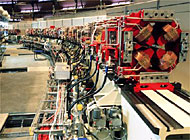Cutting edge technology sheds light on matter

The project has cost SFr159 million and has taken ten years to complete. Now the Swiss Light Source (SLS) at the Paul Scherrer Institute in Villigen is officially up and running.
The SLS is able to probe the fundamental structure of matter with x-rays. For most tasks, it is the most advanced machine of its kind in the world.
“Within its energy range, it will be the world-leading machine for a couple of years, allowing us to do top-level research,” said the institute’s director, Professor Meinrad Eberle.
Housed in a doughnut-shaped building, the SLS is simultaneously a gigantic x-ray tube and a huge microscope packed with 600 magnets, 300 vacuum pumps and 45 kilometres of power cables.
New drugs and materials
The machine makes electrons fly extremely fast so that they emit synchrotron light. These synchrotron x-rays can penetrate deep into a material and reveal its structure. The information will help scientists better understand the fundamental workings of matter and will aid them in the development of new drugs and materials.
“You can look at protein structures and analyse their composition, molecule by molecule,” said Albin Wrulich, who heads the SLS project. “This is extremely useful for the generation of new medicines. You can look at the composition of a bone and study the degradation due to osteoporosis.”
Just as information on atomic structure promises novel possibilities for the development of new drugs, so changing the atomic structure of materials to engineer new properties offers a range of applications from nanotechnology to superconductivity.
“You could investigate materials and improve the hardness or the reflectivity or the catalytic properties of the surfaces,” said Wrulich.
Brilliant light
The SLS outperforms all national synchrotron radiation facilities built to date.
“This machine produces light with extremely high brilliance,” said Eberle. “You are therefore able to do very accurate measurements very fast. With very high brilliance, you can also investigate very small samples.”
“It is sometimes difficult to make reasonable size crystals out of proteins,” added Wrulich. “If you have extremely high brilliance, as we have at the Swiss Light Source, a very small crystal is sufficient to make a meaningful picture and look at the structures. A crystal the size of ten microns (one millionth of a metre) is sufficient to be analysed by this brilliant light.”
Producing synchrotron light is a three stage process. The electrons are initially accelerated up to 100 million electronvolts. Then they are transferred into the main accelerator where the energy is rammed up to 2.4 billion electronvolts.
Competitive edge
The electrons are then transferred into the storage ring, which is the actual light source. Here the fast moving electrons, travelling close to the speed of light, are deflected by the in-built magnets, to emit synchrotron light.
The first synchrotron light source for analysis was built in 1966. Today there are about 44 of them in operation worldwide. As new and better facilities are built, older ones lose their competitive edge. The SLS has an estimated lifespan of 25 years.
The Paul Scherrer Institute is a multi-disciplinary research centre for natural sciences and technology. More than 800 external researchers from Switzerland and abroad carry out experiments at the institute every year. Users of the SLS will include national and international groups from universities and research institutes as well as industry.
The SLS will complement existing facilities at the institute such as the particle accelerator, which produces proton beams, and the spallation neutron source which generates neutrons.
by Vincent Landon

In compliance with the JTI standards
More: SWI swissinfo.ch certified by the Journalism Trust Initiative








You can find an overview of ongoing debates with our journalists here . Please join us!
If you want to start a conversation about a topic raised in this article or want to report factual errors, email us at english@swissinfo.ch.